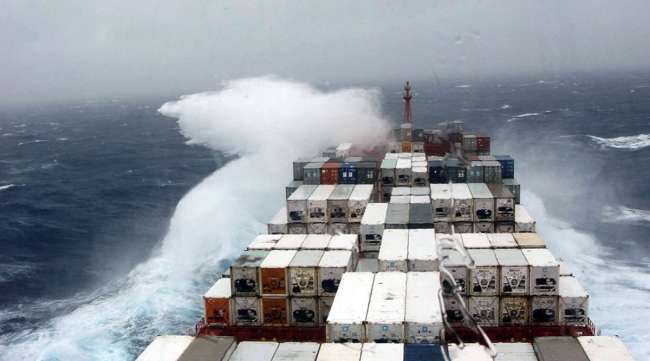Stormy Sailing Expected When Cargo Ship Fuel Standard Changes

A surge in demand is coming for diesel and related fuels as shipping companies close in on a deadline to reduce sulfur emissions.
Some analysts and market participants warned of serious market turmoil as the transition knocks the legs out from under standard marine fuels, called bunker fuels, and drives shippers to alternatives that emit less sulfur when burned. The shift in fuel purchasing is expected to spark price swings — upward for diesel and similar fuels, downward for the most common bunker fuels — and could tighten up some markets enough to create regulatory compliance problems.
The most obvious alternatives to bunker fuels are distillates — diesel fuel, home heating oil and some related fuels.
RELATED: Greek shipper bets $1 billion on fuel rule upending world trade
“It will affect the whole distillate complex,” said Kurt Barrow, vice president of the oil markets, midstream and downstream energy sectors at consulting company IHS Markit.
The markets — and the refiners supplying those markets — should be able to cope with the changes, although price spikes can be expected, and logistical problems are likely, Barrow and other specialists told Bloomberg Environment. Crude markets will be affected as demand shifts to lower sulfur crudes for making lower sulfur products, analysts added.
The International Maritime Organization in London is requiring all marine fuel to be limited to 0.5% sulfur by Jan. 1, 2020, from the current limit of 3.5%. An even lower cap, 0.1%, already exists for sulfur in fuels burned in designated coastal areas off the U.S. and Canada and in the North Sea and the Baltic Sea.
Sulfur oxides can contribute to lung disease and asthma in humans and acid rain in the environment, where changes to water acidity can harm plants and animals. The cut in marine sulfur “should have major health and environmental benefits for the world, particularly for populations living close to ports and coasts,” according to the IMO.
There are various ways shipping companies can meet the limit. They can buy low-sulfur bunker fuel or shift to low-sulfur distillate or a blended mix of those fuels, they can continue buying higher-sulfur fuel and install scrubbers to clean up emissions, or they can convert to ships burning liquefied natural gas.
RELATED: World trade, safety at risk from new fuel rule, ocean shipping group says
“Because there are so many options, there is no clear picture of how the industry is going to comply,” said Susan Grissom, chief industry analyst for the American Fuel & Petrochemical Manufacturers, a Washington trade group including refiners.
“It’s a little hard to understand exactly what the impacts are,” Patricia Yarrington, vice president and chief financial officer of Chevron Corp., said during her company’s last earnings call with analysts.
Chevron is positioned well because it produces more distillates than the residual oils used for most marine fuel currently, she said.
Residual oil can be desulfurized to make low-sulfur bunker fuel or it can be converted to petroleum coke, used in making steel, but it can easily take two years to build the necessary processing units.
“It may be getting late to make decisions to put in new equipment in a refinery,” Grissom said.
Exxon Mobil Corp. has demonstrated the lead time needed. It announced in 2014 that it will add a coker to its Antwerp refinery in Belgium. The coker has been built and is in the final stages of commissioning — four years after the final investment decision.
Forward prices for bunker fuel are sloping downward, a pattern called “backwardation,” indicating the markets are pricing in the expected decline in demand for those fuels, said Saad Rahim, chief economist for trading company Trafigura Group Pte. Ltd. in Singapore, as he spoke at a recent Energy Information Administration conference.
RELATED: Morgan Stanley says shipping revolution has oil feaded for $90
But it’s something of a surprise that forward prices for distillates aren’t yet showing a notable preparation for higher demand and higher prices in tighter markets, Rahim said.
About 1 million barrels a day of fuel demand, or a little more than that, will likely shift to distillates from bunker fuel as a result of the IMO 2020 requirement, said Chris Cote, an analyst at consulting company ESAI Energy in Wakefield, Mass.
The refining industry has great flexibility and can increase runs to pour out more distillate, Cote said. But refiners need incentives, and it remains unclear whether those monetary incentives are materializing, he said.
“There is a kind of wait-and-see game between shippers and refiners,” Cote said.
Cote suggested that the uncertainty and supply tightness in markets will continue into 2022 or 2023 before sorting itself out.
Barrow, the IHS Markit vice president, offered a similar forecast, saying it would take three to five years for the markets to find a new equilibrium.
Wholesale prices for diesel and heating oil, recently about $90 a barrel, will likely increase by about $10 a barrel because of the IMO 2020 requirement as extra demand pushes prices up, according to Barrow.




